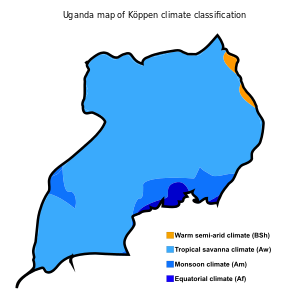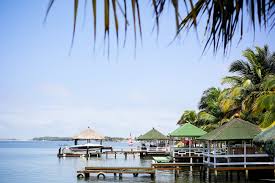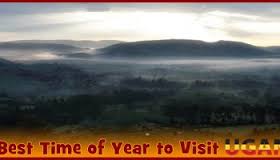TYPES OF CLIMATE REGIONS OF UGANDA



Tropical climatic region
Uganda experiences both wet and dry tropical
climate. This is so because it lies between the Tropic of Cancer and Tropic of
Capricorn.
Tropical 'climate is described as wet and dry.
Explain the
term weather.
How is climate
different from weather?
MAP OF UGANDA SHOWING RAINFALL DISTRIBUTION

Equatorial climatic region
Some few parts of Uganda experience
Equatorial climate. These are areas mainly lying on the shores of lake Victoria
such as Entebbe and the Kalangala Islands. Equatorial climate is described as
hot and wet throughout the year. It receives convectional rainfall as a result
of the presence major water bodies such as L. Victoria and the thick Mabira
Forests. Although Uganda is crossed by the Equator, it does not experience a
true equatorial climate. This is because the plateau in Uganda makes it to lie
at a relatively high altitude. The high altitude reduces the temperature which
would be very high.
This climate is described as hot and dry. The temperature is
very high and rainfall is very low. This type of climate is experienced in the
Northern and North Eastern Parts of Uganda in the districts such as Kaabong,
Kotido, Moroto Napak, Nakapiripiriti, Amuru and Oyam.
This type of climate is experienced in
mountainous and highland areas. Highlands experience low temperatures because
of the high altitude. Some highland areas also receive plenty of rainfall
because they are good water catchment areas. They influence rain formation.
This type of climate is experienced in areas like Mbale, Kisoro, Bundibugyo and
Kabale.
Influence of physical features
on climate
Influence of highlands on
climate
Highlands modify the temperature of an
area. Areas that have highlands experience low temperatures. The higher the
altitude the lower the temperature. Such places with such conditions experience
a cool climate. Highlands influence the formation of relief rainfall. Moist
winds are forced up the mountain. Clouds are formed and rainfall is received.
The windward side of the mountain receive a lot of rainfall. Some highlands are
sources of rivers, these rivers tend to modify the climate of an area. Some
highlands have thick forests, which also influence rain formation.
The lee ward side of a mountain is dry because experiences
dry winds. Therefore, it forms a rain shadow.
Formation of Relief Rainfall

Activity
Study the diagram above and answer the questions below,
1. In small
groups, discuss how is relief rainfall formed?
2. What name is
given to the side which receives rainfall?
3. What happens at
the condensation point?
When winds blow over large water bodies, they pick up
moisture. When the blowing winds get to the highland areas, they are forced to
rise through evaporation process up in the atmosphere. The moisture condenses
to form clouds and later rain droplets are received.
Influence of water bodies on climate
When the sun heats the water bodies, the water gets heated
and evaporates. The moisture rises up in the atmosphere, condenses, forms
clouds and later results into rain droplets.
Land and sea breeze
A sea breeze causes convectional rainfall which blows usually
during the afternoon from the sea to the land depending on the level of heating
and cooling of land and water. Temperatures on land get warmer during the day.
The wind from the sea is blown towards land to cool it down. This leads to

During the night land cools down quicker than the sea. The
sea takes long to cool down during the night. Land breeze usually cause rain at
night. It is accompanied by lightning and thunder.

Plains are mainly covered with short grass with scattered
trees. These areas are always dry because of limited transpiration and
therefore less rainfall is formed.
Cyclonic rainfall is at times received in these areas. This
rainfall is formed when a cold dry air mass meets with a warm moist air mass.
The cold heavy air mass forces the warm light air mass to rise. The moisture
reaches the condensation point, forms clouds and comes down as rain.
How do plains
influence climate conditions of an area?
Rift valley
A rift valley is formed when there is faulting within the
earth's crust, and the central block sinks due to tensional, or compressional
forces.
As a result of that process, these areas experience very high
temperatures because they lie at a low altitude.
The forests which grow at the rift valley base and the
escarpments contribute to rain formation in some areas .
How does the rift valley influence climate of an area?
Plateaus
The plateau is a flat raised area more than the area that surrounds it. This increase in altitude causes a decrease in temperature. Uganda and Democratic Republic of Congo for example both lie along the Equator but they experience different climatic conditions. Democratic Republic of Congo experiences higher temperatures than Uganda. This is because Uganda lies at a higher altitude than the Democratic Republic of Congo.
What is a plateau?
How
does the plateau affect climate?
Influence of climate on human activities.
People who live in areas with reliable rainfall practice crop farming. Those in areas which do not receive reliable rainfall they usually practice nomadic pastoralism. There are some crops however those are grown in places that do not receive reliable rainfall. These are called drought resistant crops.
Wet
climatic conditions favour the following crops
such as Bananas, coffee, tea, sweet potatoes, wheat, maize, groundnuts, yams,
cocoa vegetables, irish potatoes, sugarcane, fruits and oil palm
Dry
climatic conditions favour the drought resistant
crops such as; Millet, sorghum, cassava, simsim and sunflower.
Why is it important for farmers to know the
climate of an area?